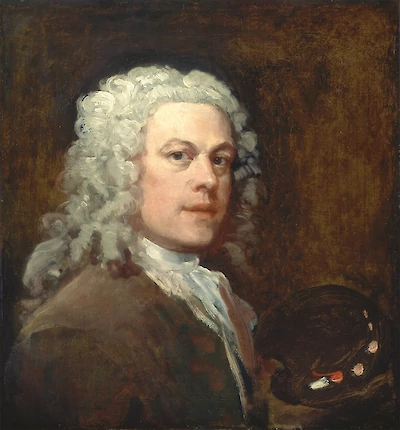

William Hogarth
A printmaker analyzes taste — and beauty comes out on top
1697 – 1764Simplicity, without variety, is wholly insipid, and at best does only not displease; but when variety is joined to it, then it pleases, because it enhances the pleasure of variety, by giving the eye the power of enjoying it with ease.
There is no object composed of straight lines, that has so much variety, with so few parts, as the pyramid: and it is its constantly varying from its base gradually upwards in every situation of the eye, without giving the idea of sameness, as the eye moves round it, that has made it been esteemed in all ages in preference to the cone, which in all views appears nearly the same, being varied only by light and shade.
Steeples, monuments, and most compositions in painting and sculpture, are kept within the form of the cone or pyramid, as the most eligible boundary, on account of their simplicity and variety. For the same reason, equestrian statues please more than the single figures.
The authors — for there were three concerned in the work — of as fine a group of figures in sculpture, as ever was made, either by ancients or modems, I mean Laocoon and his two sons, chose to be guilty of the absurdity of making the sons of half the father’s size, though they have every othermark of being designed for men, rather than not bring their composition within the boundary of a pyramid, figure 2, plate 7. Thus if a judicious workman were employed to make a case of wood, for preserving it from the injuries of the weather, or for the convenience of carriage, he would soon find by his eye, the whole composition would readily fit and be easily packed up, in one of a pyramidal form.
Steeples, etc. have generally been varied from the cone, to take off from their too great simplicity, and instead of their circular bases, polygons of different, but even numbers of sides, have been substituted, I suppose, for the sake of uniformity. These forms, however, may be said to have been chosen by the architect, with a view to the cone, as the whole compositions might be bounded by it.
Yet, in my mind, odd numbers have the advantage over the even ones, as variety is more pleasing than uniformity, where the same end is answered by both ; as in this case, where both polygons may be circumscribed by the same circle, or, in other words, both compositions bounded by the same cone.
And I cannot help observing, that nature in all her works of fancy, if I may be allowed the expression, where it seems immaterial whether even or odd numbers of divisions were preferred, most frequently employs the odd, as, for example, in the indenting of leaves, flowers, blossoms, etc.
The oval also, on account of its variety with simplicity, is as much to be preferred to the circle, as the triangle to the square, or the pyramid to the cube; and this figure lessened at one end, like the egg, thereby being more varied, is singled out by the author of all variety, to bound the features of a beautiful face.
When the oval has a little more of the cone added to it than the egg has, it becomes more distinctly a compound of those two most simple varied figures. This is the shape of the pineapple, figure 3, plate 8, which nature has particularly distinguished by bestowing ornaments of rich Mosaic upon it, composed of contrasted serpentine lines, and the pips, as the gardeners call them, figure 4, plate 8, are still varied by two cavities and one round eminence in each.
Could a more elegant simple form than this have been found, it is probable that judicious architect. Sir Christopher Wren, would not have chosen the pineapples for the two terminations of the sides of the front of St. Paul’s; and perhaps the globe and cross, though a finely varied figure, which terminates the dome, would not have had the preference of situation, if a religious motive had not been the occasion.
Thus we see simplicity gives beauty even to variety, as it makes it more easily understood, and should be ever studied in the works of art, as it serves to prevent perplexity in forms of elegance; as will be shown in the next chapter.